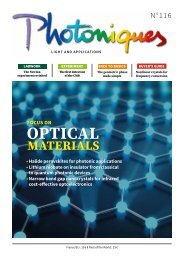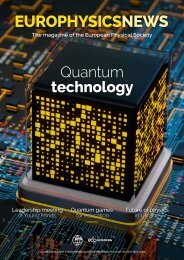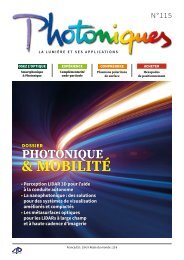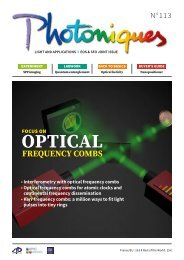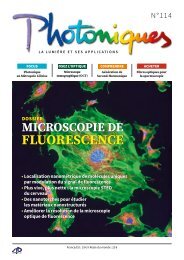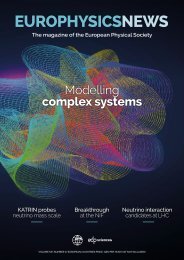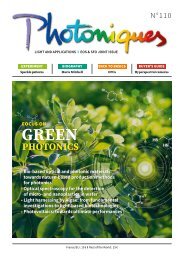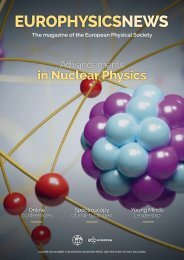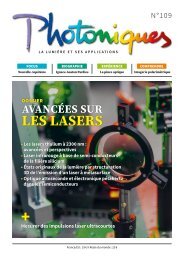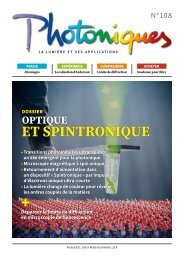EPN 53-3
Create successful ePaper yourself
Turn your PDF publications into a flip-book with our unique Google optimized e-Paper software.
FEATURES<br />
LASERS FOR HEALTH<br />
m FIG. 1:<br />
OCT image of the<br />
retina of a patient<br />
affected by diabetic<br />
macular edema (both<br />
intraretinal and<br />
subfoveal subretinal<br />
fluid are present in<br />
the image). Image by<br />
Dr. Caterina Toma and<br />
prof. Stefano De Cillà<br />
. FIG. 2:<br />
Laser treatment<br />
being done inside<br />
a mobile eye van<br />
for a patient with<br />
diabetic retinopathy.<br />
by Rajesh Pandey.<br />
Copyright CC<br />
BY-NC-SA 2.0.<br />
higher accuracy with respect to the naked eye.<br />
Fluorescence guided surgery uses the orally administered<br />
5-aminolevulinic acid (ALA) which accumulates in<br />
the tumour tissues and is metabolically activated to form<br />
protoporphyrin IX, with intense red fluorescence. ALA<br />
assisted surgery allows a complete tumor resection with<br />
significantly improved outcome. Another successful imaging<br />
technique is optical coherence tomography (OCT),<br />
which exploits interference of low-coherence broadband<br />
light to obtain a 3D image of light back-scattered by a<br />
tissue with high spatial resolution (down to a few μm)<br />
at depth of up to several mm [11]. OCT has become<br />
a standard technique in ophthalmology, as it allows to<br />
obtain high resolution images of the retina morphology.<br />
It is the standard for diagnosis of pathologies such as<br />
glaucoma, diabetic retinopathy (see Fig. 1) and age-related<br />
macular degeneration. Time Domain Near-infrared<br />
Spectroscopy (TD-NIRS) uses the absorption and scattering<br />
of short (picosecond) laser pulses to measure the<br />
concentration and localization of various components of<br />
tissues, such as oxy- and deoxyhemoglobin, lipids and<br />
water. TD-NIRS allows non-invasive monitoring of tissue<br />
hemodynamics and oxidative metabolism, for studies of<br />
functional activation in our brain [12] and diagnosis of<br />
a variety of diseases.<br />
Lasers for surgery<br />
With respect to the use of a scalpel, laser surgery has the<br />
advantage of being a non-contact technique and to enable<br />
high precision in tissue removal, limiting the damage<br />
to the adjacent tissue and, in some cases, cauterizing<br />
the surrounding vascular network. Among the factors<br />
that dictate the choice of the wavelength for laser surgery<br />
are the absorption coefficient of the tissue and the<br />
availability of optical fibers for endoscopic light transport.<br />
As tissues are made mostly of water, it is instructive to<br />
consider the water absorption coefficient, which peaks<br />
in the infrared around 3 μm, where Erbium lasers emit;<br />
however, no convenient optical fibers are available at this<br />
wavelength. A secondary maximum occurs around 2 μm,<br />
where Holmium lasers emit, a wavelength that can be<br />
easily guided by optical fibers. Light absorption is also<br />
very high in the UV range, where excimer lasers emit.<br />
Lasers find numerous applications in dermatology, for<br />
permanent air removal, skin resurfacing resulting in facial<br />
rejuvenation and removal of tattoos or port wine stains.<br />
An application currently under development is laser lithotripsy<br />
for kidney stone fragmentation, using a Holmium<br />
laser coupled to an ureteroscope. Similarly, Holmium lasers<br />
are used for the treatment of benign prostatic hyperplasia,<br />
removing the excess tissue. Erbium lasers hold<br />
promise in dentistry for the ablation of hard (dentin and<br />
enamel) dental tissue, despite the complication caused by<br />
the lack of effective delivery fibers. Low intensity laser light<br />
in the red and near infrared is used for photobiomodulation,<br />
also known as low level laser therapy, to treat inflammation,<br />
chronic pain and sport injuries. The underlying<br />
mechanisms, still not fully understood, are related to light<br />
activation of the mitochondria in the cells.<br />
Lasers find also numerous applications in ophthalmology,<br />
such as e.g. in the surgery of retinal detachment, of<br />
diabetic retinopathy (see Fig. 2) and of secondary cataract.<br />
An established application is refractive surgery for<br />
the correction of visual defects, by reshaping of the curvature<br />
of the cornea. In laser-assisted in situ keratomileusis<br />
(LASIK) a wavefront sensor first characterizes the curvature<br />
of the cornea. Subsequently, the corneal epithelium<br />
is cut creating a flap which is folded back by the surgeon<br />
to reveal the middle section of the cornea, the so-called<br />
stroma. At this point an UV excimer laser at 193 nm is<br />
used to ablate the stroma, precisely remodeling its curvature.<br />
Finally, the flap is folded back in place, and, after<br />
a short post-operative care, full visual acuity is recovered<br />
accompanied by a correction of the defect. Initially the<br />
flap was mechanically cut by a metal blade, but recently<br />
a femtosecond laser was found to give better outcomes<br />
[13]. With millions of surgeries performed and a very<br />
high degree of patient satisfaction, LASIK is an impressive<br />
example of how even sophisticated laser technologies<br />
have nowadays reached a level of maturity sufficient for<br />
their employment in mainstream applications.<br />
30 <strong>EPN</strong> <strong>53</strong>/3



